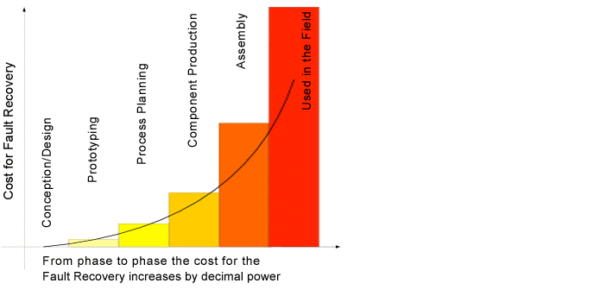Magnet-Schultz of America (MSA) decodes FMEA—identifying the most common types, answering frequently asked questions, defining the process and sharing the benefits.
Exactly what is an FMEA, and why is it necessary to invest the time in developing one?
FMEA is the abbreviation for: Failure Modes and Effects Analysis
As the name suggests, an FMEA is a systematic process employed by a company’s Sales, Engineering, Manufacturing and Quality Departments to predict and to reveal the performance and durability characteristics for components, sub-systems, and complete systems.
Developing an FMEA is all about anticipating potential causes of failures, then identifying and quantifying the risks associated with varying levels of component and system performance. The obvious emphasis is on the ramifications involving catastrophic failure which could lead to personal injury and/or loss of life.
The Most Common Types of FMEA
SFMEA—System-FMEA, which evaluates the whole system (including the products and the processes). The SFMEA is generated by the System owner (often a component manufacturer’s end customer).
DFMEA—Design-FMEA, is ideally pursued throughout the design process for new components and/or systems, but can also be undertaken when problems arise involving existing designs.
PFMEA—Process-FMEA, is employed to analyze the manufacturing and assembly processes employed to produce components and/or systems, the goal being to ensure consistent quality.
All three FMEAs bring a purposeful degree of “foresight” to the design and manufacturing stages for any product, with the intent being to avoid the “hind-sight” related “should-a-oughta” discussions that inevitably occur when products fail.
Frequently Asked Questions about FMEAs
Q: When is it necessary to go through an FMEA?
A: Anytime there is a possibility of personal injury or loss of life due to component and/or system failure.
Q: At what stage of project development should the FMEA be performed?
A: An FMEA should continue throughout the design phase of any new system and/or component design. The goal, “evolve” a design and a manufacturing process which minimize the potential for failure/risk.
Q: Who is responsible for doing the FMEA?
A: Externally—since system performance depends upon component performance, an inextricable link exists between the system and the component designers, demanding that both perform their own FMEA, then share information.
Internally—FMEAs developed by either the system and/or the component manufacturers should be the product of a knowledgeable, cross-functional team, comprised of:
• Sales (knowledge of customers and customer applications),
• Engineering (R&D knowledge of similar products, in similar applications),
• Quality (knowledge determining cause-and-effect analysis), and
• Manufacturing (knowledge gained from assembly & test of similar products/applications).
The FMEA Process
The FMEA Process is a series of if-then analyses for each item of concern:
Example—If Condition “A” exists, then what is the potential for Result “B” to occur?
Integral to this analysis is the need to establish the:
• Definition of Failure within a component and/or a system,
• Failure Mode (the design and/or material defect(s) which might cause a failure),
• Effect (consequences) of a failure,
• Probability of Occurrence,
• Probability of Detection, and
• Severity of the Result if a failure occurs
The criteria for success and failure are estimated at each step of this process. The overall analysis must also include the effect of a particular failure throughout successive levels within a system, and the impact of that failure throughout the total system.
A weighted score is kept for each step of the FMEA process, culminating in a final score, called the Risk Priority Number (RPN). The RPN is a multiple of the individual scores throughout each step in the analysis.
A common misperception is that only final RPN scores exceeding 100 require that a component and/or a system redesign be explored. FMEA training courses dispel this misconception, explaining that sole reliance on a specific RPN “threshold” (such as 100) is not a recommended practice for determining the need for action. Such thresholds assume that RPN’s are a measure of risk (which they are not) and that continuous improvement is not required (which it is).
Rather than relying on an RPN threshold, the best approach is to review all high severity items, evaluate their potential impact on failure/risk, and then decide on the correct course of action.
Example—It is possible to have a high severity which, when coupled with a low occurrence and a low detection number, would provide an RPN lower than 100. Such a scenario masks the risk because the high severity remains.
The Best Practice—Whenever a severity level is high, one must have both the vision and the discipline to explore redesigning the component and/or the system, regardless of the RPN number.
Benefits of the FMEA Process
Three benefits to be derived from properly completing an FMEA are as follows:
1. An FMEA provides quantifiable evidence relative to the voracity of component/system designs, and the manufacturing process of each, thus confirming their potential to provide safe operation.
2. As the graph below suggests, early discovery of potential design flaws, immediately leading to alternative design approaches, will avoid more costly fault recovery (redesign) efforts later in the development cycle.

3. Early establishment of optimal production processes, test criteria and test methods will ensure consistent quality and performance throughout successive production lots.
Closing
Magnet-Schultz of America is skilled at performing FMEAs. We look forward to utilizing our collaborative innovation approach to help lead you through the FMEA maze where the electromagnetic portion of your new system is concerned. Together, we can achieve both the level of safety you desire, as well as the quickest time to market.
As a leading manufacturer of standard, specialty and custom Electromagnetic devices—Electromechanical and Electrohydraulic—MSA’s advanced engineering, innovative design and lean manufacturing capabilities enable our customer’s products to outperform their competition.
To learn how MSA would incorporate FMEA into your next project , Contact MSA Today.







Leave A Comment